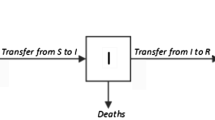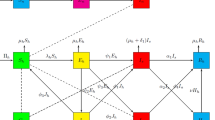Abstract
The first recorded North American epidemic of West Nile virus was detected in New York state in 1999, and since then the virus has spread and become established in much of North America. Mathematical models for this vector-transmitted disease with cross-infection between mosquitoes and birds have recently been formulated with the aim of predicting disease dynamics and evaluating possible control methods. We consider discrete and continuous time versions of the West Nile virus models proposed by Wonham et al. [Proc. R. Soc. Lond. B 271:501–507, 2004] and by Thomas and Urena [Math. Comput. Modell. 34:771–781, 2001], and evaluate the basic reproduction number as the spectral radius of the next-generation matrix in each case. The assumptions on mosquito-feeding efficiency are crucial for the basic reproduction number calculation. Differing assumptions lead to the conclusion from one model [Wonham, M.J. et al., [Proc. R. Soc. Lond. B] 271:501–507, 2004] that a reduction in bird density would exacerbate the epidemic, while the other model [Thomas, D.M., Urena, B., Math. Comput. Modell. 34:771–781, 2001] predicts the opposite: a reduction in bird density would help control the epidemic.
Similar content being viewed by others
References
Anderson, R.M., May, R.M. 1991. Infectious Diseases of Humans, Oxford University, Oxford.
Bowman, C., Gumel, A.B., van den Driessche, P., Wu, J., Zhu, H., 2005. A mathematical model for assessing control strategies against West Nile virus. Bull. Math. Biol. 67, 1107–1133.
Caswell, H., 2001. Matrix Population Models, Sinauer, Sunderland, MA.
Diekmann, O., Heesterbeek, J.A.P., 1999. Mathematical Epidemiology of Infectious Diseases: Model Building, Analysis and Interpretation, Wiley, New York.
Higgs, S., Schneider, B. S., Vanlandingham, D. L., Klingler, K. A., Gould, E. A., 2005. Nonviremic transmission of West Nile virus, PNAS, 102, 8871–8874.
Kay, B.H., Saul, A.J., McCullagh, A., 1987. A mathematical model for the rural amplification of Murray Valley Encephalitis virus in Southern Australia. Am. J. Epidemiol. 125(4), 690–705.
Li, C.-K., Schneider, H., 2002. Application of Perron-Frobenius theory to population dynamics. J. Math. Biol. 44, 450–462.
Lord, C.C., Day, J.F., 2001. Simulation studies of St. Louis Encephalitis virus in South Florida. Vector Borne Zooton. Dis. 1(4), 299–315.
Lord, C.C., Day, J.F., 2001. Simulation studies of St. Louis Encephalitis virus and West Nile viruses: The impact of bird mortality. Vector Borne Zooton. Dis. 1(4), 317–329.
McCallum, H., Barlow, N., Hone, J., 2001. How should pathogen transmission be modelled? Trans. Ecol. Evol. 16(6), 295–300.
Tapaswi, P.K., Ghosh, A.K., 1999. Dynamics of Japanese Encephalitis—A study in mathematical epidemiology. IMA J. Math. Appl. Med. Biol. 16(10), 1–27.
Tapaswi, P.K., Ghosh, A.K., Mukhopadhyay, B.B., 1995. Transmission of Japanese Encephalitis in a 3-population model. Ecol. Modell. 83, 295–309.
Thomas, D.M., Urena, B., 2001. A model describing the Evolution of West Nile-like Encephalitis in New York City. Math. Comput. Modell. 34, 771–781.
van den Driessche, P., Watmough, J., 2002. Reproduction numbers and sub-threshold endemic equilibria for compartmental models of disease transmission. Math. Biosci. 180, 29–48.
Wonham, M.J., de Camino-Beck, T., Lewis, M.A., 2004. An epidemiological model for West-Nile virus: Invasion analysis and control application. Proc. R. Soc. Lond. B 501–507.
Author information
Authors and Affiliations
Corresponding author
Rights and permissions
About this article
Cite this article
Lewis, M.A., Rencławowicz, J., Driessche, P.v.d. et al. A Comparison of Continuous and Discrete-time West Nile Virus Models. Bull. Math. Biol. 68, 491–509 (2006). https://doi.org/10.1007/s11538-005-9039-7
Received:
Accepted:
Published:
Issue Date:
DOI: https://doi.org/10.1007/s11538-005-9039-7




